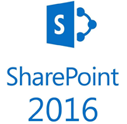
In short, SharePoint 2016 is a browser-based collaboration, or an extensible platform for creating sites within the intranet environment which is developed by Microsoft. The previous two versions are MOSS 2007 and SharePoint 2010.This is latest version of SharePoint that is currently present in the market. The main features of SharePoint 2013 are UI – A very Rich UI compared to previous versions, Social Computing – A feature which helps in creating a Facebook like environment within your corporate portal, Search – A feature which allows you to create a private search engine for the sites, generating SharePoint apps that you will be creating within the SharePoint.
SharePoint is built on .Net API and is considered as one of the best tools for creating Web Portals. So, today 2 out of 3 corporate companies have SharePoint tool, creating opportunities for not only technical professionals like .NET developer, system administrator but also business consultant or designers. Many companies are hiring SharePoint administrators and developers to work with them, and Deccansoft SharePoint training institute is training students' placement ready. We have trainers who are well experienced on all the versions of SharePoint, and can effortlessly teach freshers and those who want to migrate from one version to other.
Microsoft SharePoint 2016 training in Hyderabad, at Deccansoft is considered to be one of the reputed training institutes. We take care that this course would meet the industry requirements and would be beneficial for both fresher's as well as who have already worked on SharePoint's previous versions. At our SharePoint 2016 training institute we not only help the student to expertise the subject but also help them in gaining good practical knowledge. Deccansoft provides an excellent course material which contains important points about the topic, sample programs and detailed walkthroughs so that Students can practice and can refer them when needed or before the interviews.
Fundamental and Designing Module
Administration Module
Development Module
SharePoint Fundamentals and Designer: MS-Office Products, HTML basics
SharePoint Administrator : Working Knowledge of Windows Server OS
SharePoint Developer: C# and ASP.Net, Sql-Server
1. Avoids Feature Activation overhead
2. Handles at the Content Database level
1.Upgrading from SharePoint 2013 to SharePoint 2016 requires no site collection upgrade
process, all sites are automatically put into 2016 mode.
2.No migration from previous versions other than 2013
3.Shared Service model still supported when upgrading from SharePoint 2013
1.New navigation experience
2.Consistent navigation between O365 and SharePoint on-premise
3.Quickly launch your applications
1.Set ODF file as the default file template for a document library
2.New UI significance for Document Library
3.Data loss prevention is improved and adds more features such as new On Hold policy Site Collection templates and document delete policy templates.
1.Office 365 features are added into SharePoint 2016
2.harePoint 2016 has now updated the ribbon from SharePoint 2013 to match the Office 365 ribbon, meaning that if users are swapping between systems, there will be a consistent experience.
3.Office 365 is added to the Quick Lanch bar in Central Administration Site.
4.From Central Administration Site only, we would Configure Office 365 Yammer, hybrid OneDrive and site Features
1.SMTP connections now support TLS
2.SAML claims-based authentication is the preferred and default authentication method (NTLM and Kerberos will continue to be supported)